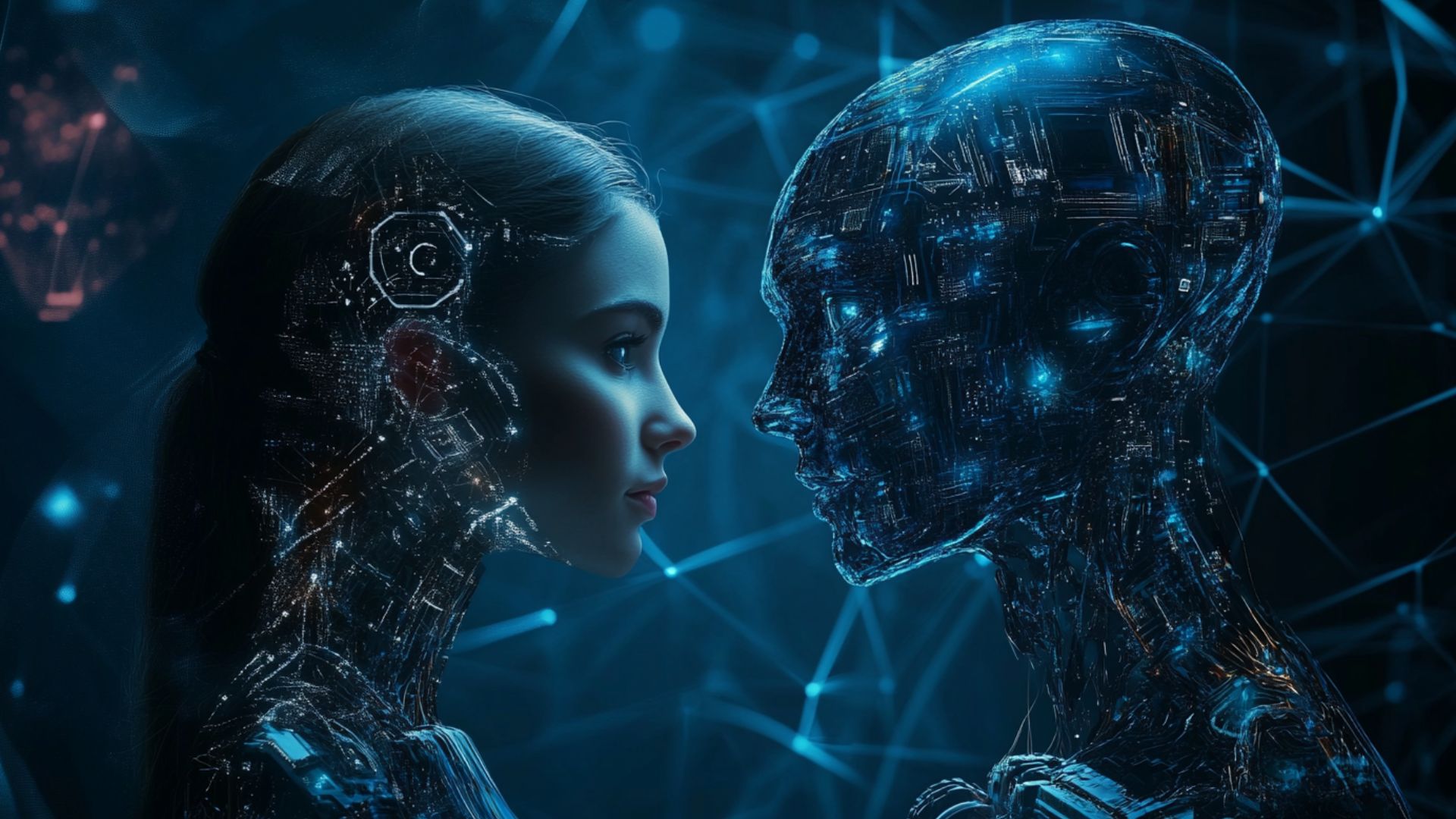Artificial Intelligence (AI) vs. Machine Learning

Technology plays a crucial role in building effective strategies and achieving success across all industries. AI and machine learning are now used extensively across numerous sectors and applications. These technologies help improve people's work processes and daily lives significantly. Advanced tools and systems ensure smooth operations and enhanced customer communication experiences.
Smart homes, rapid data analysis, and time-saving solutions are all achieved through advanced technology. Understanding the difference between artificial intelligence and machine learning requires careful analysis and consideration. AI represents a broad concept that streamlines work processes and enhances security through intelligent monitoring.
AI uses human-like intelligence and decision-making as the primary foundation of this technology. Machine learning is distinguished by systems that learn from historical datasets, continuously improving through experience. The difference between artificial intelligence vs. machine learning is important for improving decision-making processes. Using intelligent tools remains essential for optimizing business operations and workflows.
Understanding Artificial Intelligence (AI)
Today, it's essential to understand "what is AI?" and "what are AI models?" Artificial intelligence is used across many industries to improve operational efficiency. AI systems can imitate human language and thought processes while solving complex problems. AI represents the most effective way to handle routine tasks and repetitive processes.
Companies use artificial intelligence to boost productivity and accelerate work processes significantly. The foundation of AI vs. machine learning includes rule-based systems that operate on deep learning principles. Here are the main capabilities of artificial intelligence systems:
- Reasoning. AI can think logically and solve specific problems through structured analysis. Companies commonly deploy AI to enhance customer communication and support services.
- Planning. An essential advantage of AI is its ability to make informed decisions. Based on available data, AI makes strategic decisions to achieve specific business objectives.
- Natural Language Processing (NLP). AI uses NLP for accurate communication and interpretation of human language. This capability enables systems to understand and respond to customer inquiries naturally.
- Computer Vision. Vision capabilities allow systems to recognize visual information across various platforms. This approach helps companies utilize images and videos for business operations effectively.
- Robotics. AI technology controls physical machines and automated systems for business applications. Companies often use robotics for accelerated and cost-effective operational processes.
The history and evolution of artificial intelligence offers fascinating insights into technological development. Initially, AI systems used logic-based foundations and rule-driven decision-making processes. Early AI ML and deep learning approaches provided significant advantages for businesses. Connecting logical thinking with defined tasks allowed companies to achieve operational success.
Today, neural networks and vast amounts of data drive AI capabilities. Modern AI systems offer numerous solutions that provide substantial benefits for business operations.
What is Machine Learning?
Machine learning is a subset of artificial intelligence focused on data-driven learning approaches. ML is characterized by learning from past interactions to generate specific responses. Each task helps improve performance when working with large datasets and complex information.
This process improves performance through large-scale data analysis and pattern recognition. AI learning models are extremely important for dynamic systems that adapt over time. Models learn patterns to improve decision-making processes and operational efficiency. Machine learning can make predictions and continuously improve performance with additional data.
More data helps improve workflows and enables exploration of new predictive models. Here are the main types of machine learning approaches:
- Supervised Learning. Models are trained on labeled datasets with known input-output relationships. This process involves detecting spam comments and preventing fraudulent activities automatically. Continuous learning helps improve accuracy and work effectively with new data.
- Unsupervised Learning. This approach uses unlabeled data to discover hidden patterns and structures. Companies use unsupervised learning for customer segmentation and anomaly detection across systems. This process helps adjust tactics and strategies based on data-driven recommendations.
- Reinforcement Learning. ML systems interact with their environment to optimize performance through feedback. Systems receive feedback to improve performance and adapt to changing conditions. This approach is commonly used in robotics and gaming environments for optimization. Companies use this technique to improve performance and customize workflows effectively.
Key Techniques in Machine Learning
Machine learning algorithms are essential for solving complex business problems and challenges. Companies provide foundations for continuous learning and operational improvement through these methods. These algorithms vs. AI provides effective approaches to solving problems through data-driven learning processes. Methods help improve interactions and efficiency in business workflows.
Understanding the relationship between algorithms and AI is crucial for business success. Here are the main approaches to understanding machine learning applications:
- Regression. Regression algorithms are essential for predicting numerical values and continuous outcomes. Regression determines data patterns such as temperature, pricing, and other vital business processes. A prime example is estimating product prices based on popularity and market relevance. Various characteristics are analyzed to provide reliable data insights for companies.
- Classification. Classification involves assigning categories or labels to data points based on their characteristics. This process determines data relevance and accuracy for business decision-making purposes. The process resembles sorting customers based on their importance and value to companies.
- Clustering. It is essential to understand "what is an AI model?" and how machine learning works. Machine learning uses clustering models for improved data organization and pattern recognition. Clustering helps group similar data points without using predefined labels or categories. A prime example is segmenting emails based on relevance and customer engagement levels. Clustering organizes data to provide clear insights for business strategy development.
- Neural Networks. Neural networks are extremely important for mimicking human brain processing capabilities. These systems can understand complex patterns like humans and provide structured, accurate responses. Neural networks help identify complex data patterns and detect errors in systems. A prime example is image and facial recognition for security applications.
- Decision Trees. Decision trees make decisions by systematically dividing data based on specific criteria. This process uses rule-based logic similar to flowcharts for problem-solving approaches. Questions lead to clear solutions and straightforward answers for business challenges. A good example of ML meaning is solving customer problems based on demographics, income, and age data.
Use Cases of Machine Learning in Business
Machine learning is widely used in business operations and organizational management systems. ML enables teams to make informed decisions and improve operational efficiency significantly. Machine learning serves as an excellent tool for optimizing numerous business operations. Customer interaction represents an integral part of successful ML implementation strategies.
Customers receive enhanced experiences based on the deployment of quality ML tools. Here are the main business use cases for machine learning:
- Customer Segmentation. Customer segmentation represents an integral part of effective machine learning implementation. Customer grouping is based on preferences, demographics, and value to the company. Demographics and behavioral patterns are considered during the segmentation process for accuracy. The main advantage involves personalized campaigns and targeted marketing strategies for different groups. Companies use various methods to segment customers for relevant offers and experiences.
- Fraud Detection. ML systems use specialized methods to detect fraudulent activities and security threats. These systems identify suspicious situations before they can damage company operations. The main advantages include reduced financial losses and increased security across all systems. These systems are commonly used in financial departments and banking institutions. Banks use machine learning to minimize fraudulent activities in transaction processing systems.
- Recommendation Systems. Recommendation systems provide another significant advantage for offering personalized experiences. Machine learning determines relevant content, products, and services for individual customers. These systems provide customers with special discounts and personalized offers based on behavior. The main advantage is increased user engagement and improved customer experience. Netflix serves as a prime example, providing shows and movies based on viewing history.
- Chatbots. AI learning models use virtual assistants and chatbots to improve customer interactions. The main advantages include 24/7 question answering, instant support, and reduced response times. Customers receive accurate and up-to-date information along with excellent service experiences. A prime example is chatbots in the hospitality industry for customer service. These systems help identify available rooms and recommend establishments for customers.
Core Differences Between AI and Machine Learning

Most companies use both artificial intelligence vs. machine learning for different purposes. These terms have distinct meanings and offer specific advantages in different applications. Understanding the benefits and differences is crucial for solving business problems effectively. Conceptual, functional, and operational differences are essential for making informed technology decisions.
| Artificial Intelligence | Machine Learning |
| Conceptual Differences. AI is a broad field that mimics human intelligence and language capabilities. AI enables companies to make decisions, process language, and perceive information effectively. AI encompasses reasoning and learning to improve efficiency and customer communication. | Conceptual Differences. Machine learning is a subset of artificial intelligence focused on specific applications. ML focuses on learning from data and past interactions to improve performance. ML systems use algorithms to enhance customer interactions and business processes. |
| Functional Differences. AI can mimic human language and communication styles for natural interactions. AI solves complex human problems comprehensively across multiple domains. AI can interact and operate without requiring extensive predefined datasets. | Functional Differences. Machine learning recognizes patterns and predicts outcomes based on historical data. By learning from past interactions, ML offers accuracy and specificity in predictions. ML excels at finding patterns in large datasets for specific applications. |
| Operational Differences. AI ML deep learning can operate using various approaches including rule-based and data-driven methods. Depending on the task and interaction requirements, AI can adapt approaches. | Operational Differences. Machine learning requires large amounts of data on a continuous basis. ML learns from previously established datasets and offers specific, data-driven answers. |
Are All AI Systems Based on Machine Learning?
It's important to understand that not all AI systems are based on machine learning. Machine learning drives the success of many AI applications through continuous learning processes. ML helps companies improve customer communication and optimize operational systems effectively.
However, it's crucial to understand that AI ML deep learning doesn't always require machine learning. AI can exist independently and provide value through different approaches and methodologies.
- Symbolic Artificial Intelligence. Symbolic AI is based on coded rules and logical reasoning systems. The use of symbols and logic helps systems use structured thinking processes. Companies use symbolic AI to solve complex problems through rule-based approaches. Based on predefined rules, AI can operate effectively without continuous learning requirements.
- Expert Systems. Non-machine learning AI programs are built using specialized knowledge and strategies. These systems are constructed using extensive databases and domain-specific expertise. Expert systems are used for accurate decision-making processes and ongoing operational support. These systems are used by companies in medicine, finance, and law firms.
AI ML and deep learning are essential for improving overall business interactions and efficiency. However, AI can exist without machine learning and provide significant advantages independently. AI systems use heuristic search algorithms to solve complex actions and planning challenges. These approaches are used in robotics and gaming platforms for optimization.
Logical reasoning systems include formal logic and rule-based processing capabilities. Companies use these systems to understand natural language and communicate with customers.
Where AI and ML Overlap
ML and AI together help achieve significant success for modern companies. Their intersection represents an extremely important mechanism for advanced business systems. The combination of AI and machine learning provides the best approach for rule compliance. Systems can learn and adapt while making decisions simultaneously for optimal performance.
More intelligent hybrid systems contribute to improved interactions between companies and customers. Customers receive excellent experiences, and companies invest in quality technological tools. Here's how AI and ML integration manifests in business applications:
- Computer Vision. Machine learning algorithms are essential for recognizing and interpreting visual data. Computer vision is used in security systems and medical imaging applications. This process recognizes facial features and important visual characteristics for business applications.
- Natural Language Processing. NLP is extremely important for effective customer interaction and communication. Systems can generate human-like language for improved customer engagement and interaction. Companies use various applications, chatbots, and virtual assistants for language analysis.
- Autonomous Systems and Robotics. The combination of AI and ML is essential for autonomous systems. AI excels at decision-making and general operational management tasks. Machine learning provides reliable tools for helping systems learn and adapt continuously. Systems improve performance and enhance interactions based on real-time data analysis.
- Predictive Analytics. Predictive analytics represents critical synergy between AI and machine learning technologies. AI uses machine learning to analyze and process large amounts of data. This process creates accurate forecasts and recommendations for business strategy development. Predictive analytics and decision support are used in healthcare, finance, and marketing.
- Gaming and Simulation. In gaming applications, machine learning improves AI performance significantly. There's adaptation to complex strategies and building optimal decision-making processes. Companies use this combination for personalization and enhanced player experiences.
Benefits and Limitations of Each

Understanding the AI vs. machine learning comparison is fundamental for business success. It's important to familiarize yourself with the advantages and limitations of each approach. Companies can choose the best tools for their specific workflows and productivity requirements. For improved results and customer engagement, understanding both types is essential.
Flexibility:
- Artificial Intelligence. AI can be both rule-based and autonomous depending on application requirements. It provides reliable results across various situations and business contexts. AI offers structured and precise decision-making capabilities with consistent logic and operation.
- Machine Learning. Machine learning integration provides a reliable way to improve system flexibility significantly. Machine learning offers high flexibility but requires continuous retraining and data updates. ML is ideal for high-performance environments and continuous operational improvement.
Accuracy:
- Artificial Intelligence. AI provides increased accuracy based on well-managed data and structured approaches. AI is limited in tasks that require constant adaptation to new situations. The main disadvantage is inability to improve performance without human interaction and oversight.
- Machine Learning. ML provides high accuracy for large-scale datasets and complex pattern recognition. The main disadvantage is that accuracy depends on data quality and algorithm tuning. ML excels in image recognition and fraud detection applications.
Interpretability:
- Artificial Intelligence. Algorithms vs. AI systems are transparent with the ability to track and continuously improve. The main advantage is using AI with high levels of relevance and explainability.
- Machine Learning. ML has challenges with deep learning model interpretability and explanation. For specific applications requiring interpretable models, ML provides excellent solutions. The main disadvantage is difficulty justifying decisions in real-time applications.
Future Outlook: AI and ML in the Next Decade
The future promises transformational improvements in productivity and enhanced business interactions. Transformational approaches in AI and machine learning represent innovative platforms for industries. Industry development will introduce improved interactions and advancement across all business sectors.
- Explainable AI. The future promises improved solutions with increased transparency and reliability. For healthcare and finance applications, prediction explanations play crucial roles. Explainable AI is essential for complex machine learning systems requiring accountability. Human understanding and accountability will improve significantly for business applications.
- Edge AI. Edge AI provides reliable solutions for various platforms and devices. One significant advantage is reduced need for cloud processing and faster response times. Privacy protection and real-time diagnostics are improved through edge computing approaches.
- Automated Machine Learning (AutoML). Tools will simplify creating specific models without requiring deep technical knowledge. Improved data processing and optimal machine learning model selection become more accessible. The relationship between artificial intelligence vs. machine learning continues evolving and improving rapidly. Using these technologies for business will provide the best competitive advantages.
- AI Ethics. An improved approach to fairness and bias reduction plays crucial roles. Continuous improvement will provide enhanced security and strict regulatory compliance. Monitoring and auditing will ensure accountability for responsible AI usage across industries.
Artificial General Intelligence (AGI). Continuous improvements will help achieve general intelligence capabilities in AI systems. Systems will improve adaptation across different domains and business applications. Progress provides a reliable path to success and scaling for companies.


